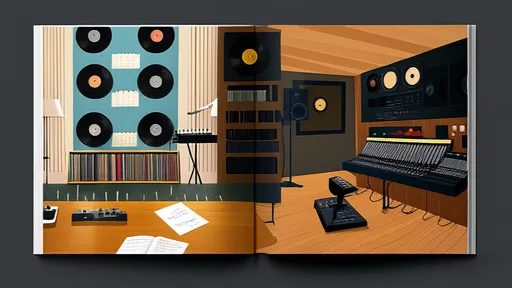For decades, the dream of making it in the music industry was synonymous with being on stage—the guitarist shredding a solo, the vocalist hitting a high note, the drummer holding down a thunderous beat. This image, perpetuated by media and myth, has long overshadowed a fundamental truth: the spotlight only illuminates a fraction of the entire ecosystem. Behind every album, every tour, and every artist's breakthrough, there exists a vast and intricate network of professionals whose work is essential yet often unseen. The journey from fan to professional within this world doesn't have to mean picking up an instrument; it can mean picking up a contract, a mixing board, or a marketing plan.
The transition often begins with a deep, abiding passion for music itself. This isn't a casual interest but a compulsion to understand not just the "what" but the "how" and "why." It's the fan who doesn't just listen to an album but devours the liner notes, credits every producer and engineer, and wonders about the business strategy behind a surprise album drop. This curiosity is the seed. It leads to blogs dissecting industry trends, university courses on music business, and internships at local venues or radio stations. It’s here that the realization dawns: you can build a life in music without ever facing an audience.
One of the most accessible entry points is the realm of music journalism and criticism. This path is for those who process their love for music through words. It's more than writing reviews; it's about contextualizing an artist's work within a larger cultural moment, conducting interviews that reveal creative processes, and telling the stories behind the songs. The digital age has democratized this field, allowing passionate writers to start their own blogs, contribute to established online publications, or build a following through insightful social media commentary. The key is developing a unique voice and a deep knowledge of both historical genres and emerging scenes.
Parallel to storytelling is the entire domain of artist management and A&R (Artists and Repertoire). Managers are the strategic architects of an artist's career, handling everything from booking and contracts to long-term brand development. They are part-businessperson, part-therapist, and part-visionary. A&R representatives, often seen as the talent scouts of the industry, are the bridge between the artist and the label. They are the ones with their ears constantly to the ground, hunting for the next big sound, and then helping to nurture that raw talent into a polished, marketable act. These roles require an intuitive understanding of music, sharp business acumen, and exceptional interpersonal skills.
Then there is the technical and creative backbone of the industry: production, engineering, and sound design. While not "performers" in the traditional sense, these individuals are deeply creative artists in their own right. The producer shapes the overall sound of a record, acting as a creative director in the studio. Audio engineers are the masters of technology, capturing and manipulating sound to achieve clarity, power, and emotion. Their work is a blend of art and science, requiring a trained ear and technical proficiency with complex software and hardware. For those fascinated by the science of sound itself, careers in acoustic engineering or live sound mixing offer a path to be literally inside the music at every concert and festival.
No artist can survive on art alone; this is where the business infrastructure comes in. The music marketing and promotions team builds the world around the music. They craft the narratives, run the social media campaigns, secure press coverage, and place songs in films, TV shows, and commercials. In the streaming era, data analysts and digital strategists have become crucial, parsing listener data to inform everything from tour routing to setlist creation. On the legal and financial side, music lawyers negotiate deals and protect intellectual property, while agents and bookers work tirelessly to get artists on the road and on the right stages.
For the academically inclined, the fields of musicology, ethnomusicology, and music therapy offer profound ways to engage with music's power. Musicologists delve into the history, theory, and cultural impact of music, often working in academia or archival preservation. Ethnomusicologists study music in its cultural context, exploring how it functions in societies around the world. Music therapists, perhaps one of the most impactful non-performance roles, use music as a clinical tool to address physical, emotional, and cognitive needs, demonstrating music's unique ability to heal and connect on a human level beyond entertainment.
The path from fan to professional in these behind-the-scenes roles is rarely linear. It is built on a combination of formal education, self-driven learning, and, most importantly, networking. Attending industry conferences, connecting with professionals on LinkedIn, and seeking out mentors are critical steps. The initial jobs are often internships or assistant roles—low-paid or unpaid, a harsh reality that remains a significant barrier to diversity in the industry. Persistence, a willingness to learn from the ground up, and a genuine love for the craft are the currencies that ultimately lead to a sustainable career.
Ultimately, the music industry is a colossal machine, and the performers are its most visible moving part. But the engine is powered by a diverse army of experts—the writers, the managers, the engineers, the marketers, the lawyers, and the scholars. Theirs is a different kind of performance, one of support, strategy, and creation from the shadows. For the passionate fan looking in from the outside, the message is clear: you don't need a spotlight to make a life in music. You just need to find your place in the chorus of voices that work in unison to make the magic happen. The industry is not a stage with a single microphone; it is a complex map, and there are countless routes to a fulfilling destination.

By /Aug 22, 2025

By /Aug 22, 2025

By /Aug 22, 2025

By /Aug 22, 2025

By /Aug 22, 2025

By /Aug 22, 2025

By /Aug 22, 2025

By /Aug 22, 2025

By /Aug 22, 2025

By /Aug 22, 2025

By /Aug 22, 2025

By /Aug 22, 2025

By /Aug 22, 2025

By /Aug 22, 2025

By /Aug 22, 2025

By /Aug 22, 2025

By /Aug 22, 2025

By /Aug 22, 2025

By /Aug 22, 2025

By /Aug 22, 2025